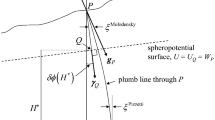Abstract
Airborne measurements of the gravitation vector and its gradients require auxiliary measurements of position and attitude, not just for registration (geolocation) purposes, but also to separate gravitational from kinematic accelerations (and gradients) according to the principle of equivalence. Very precise positioning is needed to compute accelerations by numerical differentiation, and very accurate angular rates are needed to compute orientation (by integration) and angular acceleration (by differentiation). GPS positioning and gyro data can be used for these purposes, but limits in accuracy of current technology thus also constrain the useful performance of the principal gravimetric sensors. This paper reviews the theory of airborne gravimetry and gradiometry, the sensitivities of various components of the gravitation vector, and the gradient tensor to position and attitude (rate) errors. Generally, one may conclude that scalar gravimetry and vector gravimetry are limited by orientation error coupled to the acceleration environment of the vehicle, as well as positioning (i.e., kinematic acceleration) uncertainty, while gradiometry depends, instead, on very precise angular rates of the measurement frame. The necessary error tradeoff between future developments in gradiometers and gyro technology is thereby also illustrated and shows that present gyro technology is sufficient to meet requirements for existing airborne gradiometers, but requires improvement for future gradient sensors.
Similar content being viewed by others
References
Jekeli, C., Inertial Navigation Systems with Geodetic Applications, Berlin: Walter de Gruyter, 2000.
Jekeli, C., Statistical Analysis of Moving-Base Gravimetry and Gravity Gradiometry, Report no. 466, Columbus, Ohio: Laboratory for Space Geodesy and Remote Sensing Research, Geodetic Science, 2003.
Jekeli, C., Airborne Gradiometry Error Analysis, Surv. Geophys., 2006, no. 27(2), pp. 257–275.
Jekeli, C., Correlation Modeling of the Geopotential Field in Classical Geodesy, in Handbook of Geomathematics, Freeden, W., et al., Eds., 2010.
Paik, H.J., Leung, J.S., Morgan, S.H., and Parker, J., Global Gravity Survey by an Orbiting Gravity Gradiometer, EOS, Trans. Am. Geophys. U., 1988, no. 69(48), pp. 1601–1611.
Schwarz, K.P., Colombo, O.L., Hein, G., and Knickmeyer, E.T., Requirements for Airborne Vector Gravimetry, Proc. Int. Assoc. of Geodesy Symposia, From Mars to Greenland: Charting Gravity with Space and Airborne Instruments, 1992, no. 110, pp. 273–283.
Shan, S., Bevis, M., Kendrick, E., Mader, G.L., Raleigh, D., Hudnut, K., Sartori, M., and Phillips, D., Kinematic GPS Solutions for Aircraft Trajectories: Identifying and Minimizing Systematic Height Errors Associated with Atmospheric Propagation Delays, Geophys. Res. Lett., 2007, no. 34, p. L23S07, doi: 10.1029/2007/GL030889.
van Kann, F., Requirements and General Principles of Airborne Gravity Gradiometers for Mineral Exploration, Airborne Gravity 2004, Lane, R.J.L., Ed., Abstracts from the ASEG-PESA Airborne Gravity 2004 Workshop: Geoscience Australia Record 2004/18, pp. 1–5.
Author information
Authors and Affiliations
Additional information
The article is published in the original.
Rights and permissions
About this article
Cite this article
Jekeli, C. Accuracy requirements in position and attitude for airborne vector gravimetry and gradiometry. Gyroscopy Navig. 2, 164–169 (2011). https://doi.org/10.1134/S2075108711030060
Received:
Published:
Issue Date:
DOI: https://doi.org/10.1134/S2075108711030060




